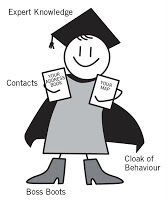DEVELOPING STAGE PRESENCE
When you have decided on the content and structure of your presentation, you can be confident that you will say what you need to say in a logical order, and you will know roughly how long it will take you. You have the material – what about putting it across in a manner which will interest and convince your audience? Your message may be as worthy and sound as you like, you will not do it justice unless you present it expertly.
Think of people who present on the radio. They are using only one vehicle to put across their message persuasively; the voice.
VOICE
When you cannot be seen, you voice is obviously of crucial importance to the delivery of your message. However, do not underestimate the role your voice plays in face to face presentations too. Your voice has a variety of range and tone which few of us use to the full. And yet think of the richness and beauty which actors can convey by the voice alone, or the humour which a skilled comedian can inject in his words simply by the timing of his delivery.
To start with, sound is affected by your muscles and ease with which air can flow through your chest, throat and mouth. Very often you can tell if someone is nervous because their voice wobbles, or they speak very quietly. To project your voice, you need to:
· relax your muscles
· breathe in through your nose and out through your mouth
· use your diaphragm to fill your lower lungs with air
You will probably feel different degrees of enthusiasm about different parts of your presentation, but do you want that to be apparent? Probably not. Put across every point with conviction. Your voice will betray the areas of your talk which you are less sure about …… but only if you let it!
VOLUME
Can your audience hear what you are saying? Are they losing the ends of the sentences or missing points because you mumble? Speaking too loud to an informal group will appear inappropriate and over formal, perhaps aggressive. Presenters often do not appreciate how far their voice carries event at its normal conversation volume.
SPEED
Do you talk fast naturally? Are you giving your audience time to take in what you are saying? If you talk too fast – write “slow down” in your notes to remind you.
TONE
Monotonous voices send audiences to sleep! You can practise varying your tone, and use rhetorical questions to raise the pitch of your voice at the end of a sentence, rather than letting it fade away. Think about speaking clearly, and articulating more than you would in a one to one conversation. Use your tongue, your lips and your teeth. Listen to the news readers on Radio 4. They only have their voice to convey items of news which can be tragic, dramatic or comic. Get a feel for how they manage to do this.
VOCABULARLY
Do not try to impress by using long words. Speakers who do often betray their ignorance by using words inappropriately or by mis-pronouncing them. Think about your audience, and use words which you are comfortable with, and they will understand.
“Jargon appeals to the illiterate, plain English to the wise”
What you can do to make your presentation appeal to each member of your audience is to choose words which speak to them. You should be aware that some people relate to the pictures which words conjure up for them, some to the sound of words and some to the feelings which they give them. So try to use a range of words which will reach everyone in the audience.
Draw pictures for visual people, and use visuals. Use “sound” phrases, like “If this sounds good to you, we will go ahead and discuss it …” for your auditory people. When your audience includes people who respond to feeling; “To get a handle on this proposal…”
This is a way of building up rapport with your audience and making sure you reach each one of them.
PAUSES
Pauses are powerful. The silence may seem to you to last for ages, because your adrenalin is running faster than normal. Pauses give people a chance to absorb your last point. You can add drama to your presentation be creating anticipation when you pause before answering a rhetorical question, or delivering interesting information. If nothing else, you can pause to recapture your audience’s attention, as they realise there is a sudden silence which makes them alert, wondering what is coming next, or whether you have lost the thread of your argument!
YOUR BODY
You are you own best visual aid. You can use your face and your gestures to add interest to your delivery. By walking forward and delivering a rhetorical question to someone in the audience you will keep every one concentrating, in case you are going to ask them to answer the question!
Use gestures naturally. When you are talking about different times, use physical space to help you. You might point over your shoulder for time in the last, in front of you for the future. If you are talking about alternatives, gesture with your right hand while you refer to one, and when with your left hand while you refer to the other.
Your gestures can inject more life into your presentations, but should always add to your message, not distract from it. They should be natural and relevant; otherwise they get in the way of your audience’s understanding, like noise on the radio or snow on the television screen.
If you don’t feel comfortable using your body in this way, try practising in front of the mirror till it feels more natural, or if you can, take the opportunity to video yourself. How does it look when you play it back?
Think about actors. They always exaggerate their gestures very slightly to create effect. If you’ve ever watched a children’s entertainer you will notice the way they use gesture and expression to provoke a response.
MANNERISMS
Be aware of the mannerisms you have a tendency to use which might be irritating or distracting for your audience. We often feel awkward, not knowing what to do with out hands, but fiddling with coins in your pocket, or gripping your pen tightly will not help. Just be aware of what your hands are doing, try to hold them relaxed at your side, or hold your prompt cards – but not so tightly that your knuckles show white!
POSTURE
As a general rule you should stand to make your presentation. This makes you the focal point for your audience, and it is easier to capture and keep their attention. Try to adopt a relaxed pose, not necessarily stock still, but without pacing up and down in a distracting fashion. Always face the audience and make eye contact with them. A useful way to calm your nerves, as well as to commend attention, is to hold one person’s eyes for 3 to 4 seconds, before moving on to someone else.
“Lighthousing” – sweeping your eyes over the audience and back without resting on anyone has far less impact. You are aiming to have a conversation with your audience, and you will make them feel you are really interested in them if you look at them directly. Try and smile and remember:
“Enthusiasm and expressiveness are seldom out of place in presenting”
A key question is out of all you have read what is the one thing that if you took action on it would make the biggest difference to you?
Here’s to your success,
Hilary
 Would you invest in a business that didn’t invest in itself? Why should a business invest in you if you’re not investing in yourself.
Would you invest in a business that didn’t invest in itself? Why should a business invest in you if you’re not investing in yourself. 








